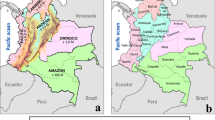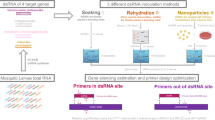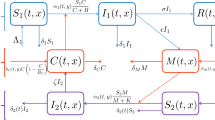Abstract
The Wolbachia-induced incompatible insect technique is a promising strategy for controlling wild mosquito populations. However, recent experimental studies have shown that mosquito migration into target areas dilutes the strategy’s effectiveness. In this work, we formulate a delay differential equation model to assess the impact of migration on mosquito population suppression. We identify that mosquito migration into an idealized target area makes it impossible to eliminate the target population completely. Our analysis identifies a lower bound of the suppression rate \(\gamma ^*\) for a given migration number, which reveals the possible maximum reduction of wild population size in the peak season. For a given suppression rate target \(\gamma _0>\gamma ^*\), we identify the permitted maximum migration number \(D(\gamma _0)\), above which is impossible to reduce the field mosquito density up to \((1-\gamma _0)\times 100\%\) in peak season. To reduce more than \(95\%\) of Aedes albopictus population during its peak season in Guangzhou within six weeks, the required minimum release number of Wolbachia-infected males climbs steeply as the migration number increases to D(0.05).





Similar content being viewed by others
References
Atkinson, M.P., Su, Z., Alphey, N., et al.: Analyzing the control of mosquito-borne diseases by a dominant lethal genetic system. PNAS 104(22), 9540–9545 (2007)
Baldacchino, F., Caputo, F., Drago, A., et al.: Control methods against invasive Aedes mosquitoes in Europe: a review. Pest Manag. Sci. 71, 1471–1485 (2015)
Curtiss, D.R.: Recent extentions of Descartes’ rule of signs. Ann. Math. 19(4), 251–278 (1918)
Dye, C.: Models for the population dynamics of the yellow fever mosquito, Aedes aegypti. J. Anim. Ecol. 53, 247–268 (1984)
Freedman, H.I.: Deterministic Mathematical Models in Population Ecology, 2nd edn. HIFR Consulting LTD, Edmonton (1987)
Goff, G.L., Damiens, D., Ruttee, A.H., et al.: Field evaluation of seasonal trends in relative population sizes and dispersal pattern of Aedes albopictus males in support of the design of a sterile male release strategy. Paras. Vect. 12, 81 (2019)
Harrington, L.C., Scott, T.W., Lerdthusnee, K., et al.: Dispersal of the dengue vector Aedes aegypti within and between rural communities. Am. J. Trop. Med. Hyg. 72, 209–220 (2005)
Hu, L., Huang, M., Tang, M., et al.: Wolbachia spread dynamics in stochastic environments. Theor. Popul. Biol. 106, 32–44 (2015)
Hu, L., Tang, M., Wu, Z., et al.: The threshold infection level for Wolbachia invasion in random environments. J. Diff. Equ. 266, 4377–4393 (2019)
Huang, M., Hu, L.: Modeling the suppression dynamics of Aedes mosquitoes with mating inhomogeneity. J. Biol. Dyn. 14(1), 656–678 (2020)
Huang, M., Tang, M., Yu, J.: Wolbachia infection dynamics by reaction–diffusion equations. Sci. China Math. 58, 77–96 (2015)
Huang, M., Yu, J., Hu, L., Zheng, B.: Qualitative analysis for a Wolbachia infection model with diffusion. Sci. China Math. 59, 1249–1266 (2016)
Huang, M., Lou, J., Hu, L., et al.: Assessing the efficiency of Wolbachia driven Aedes mosquito suppression by delay differential equations. J. Theor. Biol. 440, 1–11 (2018)
Huang, M., Tang, M., Yu, J., Zheng, B.: The impact of mating competitiveness and incomplete cytoplasmic incompatibility on Wolbachia-driven mosquito population suppression. Math. Biosci. Eng. 16(5), 4741–4757 (2019)
Huang, M., Tang, M., Yu, J., Zheng, B.: A stage structured model of delay differential equations for Aedes mosquito population suppression. Discrete Contin. Dyn. Syst. 40(6), 3467–3484 (2020)
Hui, Y., Lin, G., Yu, J., Li, J.: A delayed differential equation model for mosquito population suppression with sterile mosquitoes. Discrete Contin. Dyn. Syst. B 25(12), 4659–4676 (2020)
Huxley, P.J., Murray, K.A., Pawar, S., Cator, L.J.: Competition and resource depletion shape the thermal response of population fitness in Aedes aegypti. Commun. Biol. 5, 66 (2022)
Kyle, J.L., Harris, E.: Global spread and persistence of dengue. Annu. Rev. Microbiol. 62, 71–92 (2008)
Li, Y., Kamara, F., Zhou, G., et al.: Urbanization increases Aedes albopictus larval habitats and accelerates mosquito development and survivor shop. PLoS Negl. Trop. Dis. 8(11), e3301 (2014)
Li, D., Wan, H.: The threshold infection level for Wolbachia invasion in a two-sex mosquito population model. Bull. Math. Biol. 81, 2596–2624 (2019)
Liu, Q.: Dengue fever in China: new epidemical trend, challenges and strategies for prevention and control. Chin. J Vect. Biol. Control 31(1), 1–6 (2020)
Liu, Z., Zhang, Y., Yang, Y.: Population dynamics of Aedes (Stegomyia) albopictus (Skuse) under laboratory conditions. Acta Entomol. Sin. 28(3), 274–280 (1985)
Liu, F., Zhou, C., Lin, P.: Studies on the population ecology of Aedes albopictus 5. The seasonal abundance of natural population of Aedes albopictus in Guangzhou. Acta Sci. Nat. Universitatis Sunyatseni 29(2), 118–122 (1990)
Liu, F., Yao, C., Lin, P., Zhou, C.: Studies on life table of the natural population of Aedes albopictus. Acta Sci. Nat. Universitatis Sunyatseni 31(3), 84–93 (1992)
Parham, P.E., Michael, E.: Modeling the effects of weather and climate change on malaria transmission. Environ. Health Perspect. 118, 620–626 (2010)
Smith, H.L.: An Introduction to Delay Differential Equations with Applications to the Life Sciences, vol. 57. Springer, New York (2011)
Trájer, A., Hammer, T., Kacsala, I., et al.: Decoupling of active and passive reasons for the invasion dynamics of Aedes albopictus Skuse (Diptera: Culicidae): comparisons of dispersal history in the Apennine and Florida peninsulas. J. Vect. Ecol. 42(2), 233–242 (2017)
WHO (2012) Global Strategy for Dengue Prevention and Control 2012–2020, Aedes albopictus. World Health Organization
Xi, Z., Khoo, C.C., Dobson, S.L.: Wolbachia establishment and invasion in an Aedes aegypti laboratory population. Science 310, 326–328 (2005)
Yu, J.: Modeling mosquito population suppression based on delay differential equations. SIAM J. Appl. Math. 78(6), 3168–3187 (2018)
Yu, J.: Existence and stability of a unique and exact two periodic orbits for an interactive wild and sterile mosquito model. J. Differ. Equ. 269, 10395–10415 (2020)
Yu, J., Li, J.: Global asymptotic stability in an interactive wild and sterile mosquito model. J. Differ. Equ. 269, 6193–6215 (2020)
Yu, J., Li, J.: Dynamics of interactive wild and sterile mosquitoes with time delay. J. Biol. Dyn. 13(1), 606–620 (2019)
Yu, J., Li, J.: A delay suppression model with sterile mosquitoes release period equal to wild larvae maturation period. J. Math. Biol. 84, 14 (2022)
Zhang, L., Tan, L., Hui, A., et al.: Laboratory and field studies on the oviposition pattern of Aedes albopictus. Acta Parasitol. Et. Med. Entomol. Sin. 16, 219–223 (2019)
Zhang, X., Tang, S., Cheke, R.A.: Birth-pulse models of Wolbachia-induced cytoplasmic incompatibility in mosquitoes for dengue virus control. Nonlinear Anal. Real World Appl. 22, 236–258 (2015)
Zheng, B., Yu, J., Xi, Z., Tang, M.: The annual abundance of dengue and Zika vector Aedes albopictus and its stubbornness to suppression. Ecol. Model. 387, 38–48 (2018)
Zheng, B., Yu, J., Li, J.: Modeling and analysis of the implemention of the Wolbachia incompatible and sterile insect technique for mosquito population suppression. SIAM J. Appl. Math. 81(2), 718–740 (2021)
Zheng, B., Li, J., Yu, J.: Existence and stability of periodic solutions in a mosquito population suppression model with time delay. J. Differ. Equ. 315, 159–178 (2022)
Zheng, X., Zhang, D., Li, Y., et al.: Incompatible and sterile insect techniques combined eliminate mosquitoes. Nature 572, 56–61 (2019)
Acknowledgements
We would like to thank four anonymous reviewers for valuable and precious comments on the manuscript. This work was supported by National Natural Science Foundation of China (12226414, 11471085, 11631005, 12171112).
Author information
Authors and Affiliations
Contributions
MH and JY wrote the main manuscript text and prepared figures 1–3. All authors reviewed the manuscript.
Corresponding author
Ethics declarations
Conflict of interest
The authors declared that they have no conflict of interest.
Additional information
Publisher's Note
Springer Nature remains neutral with regard to jurisdictional claims in published maps and institutional affiliations.
Rights and permissions
Springer Nature or its licensor (e.g. a society or other partner) holds exclusive rights to this article under a publishing agreement with the author(s) or other rightsholder(s); author self-archiving of the accepted manuscript version of this article is solely governed by the terms of such publishing agreement and applicable law.
About this article
Cite this article
Huang, M., Yu, J. Modeling the Impact of Migration on Mosquito Population Suppression. Qual. Theory Dyn. Syst. 22, 134 (2023). https://doi.org/10.1007/s12346-023-00834-8
Received:
Accepted:
Published:
DOI: https://doi.org/10.1007/s12346-023-00834-8
Keywords
- Migration
- Incompatible insect technique
- Wolbachia
- Cytoplasmic incompatibility
- Mosquito population suppression
- Delay differential equation




